Strategic Marketing Management: Tourism Australia Marketing Plan
VerifiedAdded on 2022/10/14
|24
|4509
|219
Report
AI Summary
This report provides a strategic marketing plan for Tourism Australia, analyzing its operations within the Australian tourism industry. It begins with an executive summary and table of contents, followed by an introduction outlining the report's purpose and structure. The report identifies opportunities for Tourism Australia, focusing on strategic business units (SBUs) and employing the BCG Matrix to assess their market position. It delves into marketing strategies, including identifying competitive advantages, setting marketing objectives, and analyzing segmentation, target markets, and positioning. The report utilizes Porter's Generic Strategy Model and Ansoff's Growth Matrix to formulate strategies for cost leadership, differentiation, and market penetration. It emphasizes the importance of digital marketing, eco-tourism, and expanding into Asian markets to achieve sustainable growth. The report also discusses implementation and control issues, offering a comprehensive analysis of Tourism Australia's marketing plan.
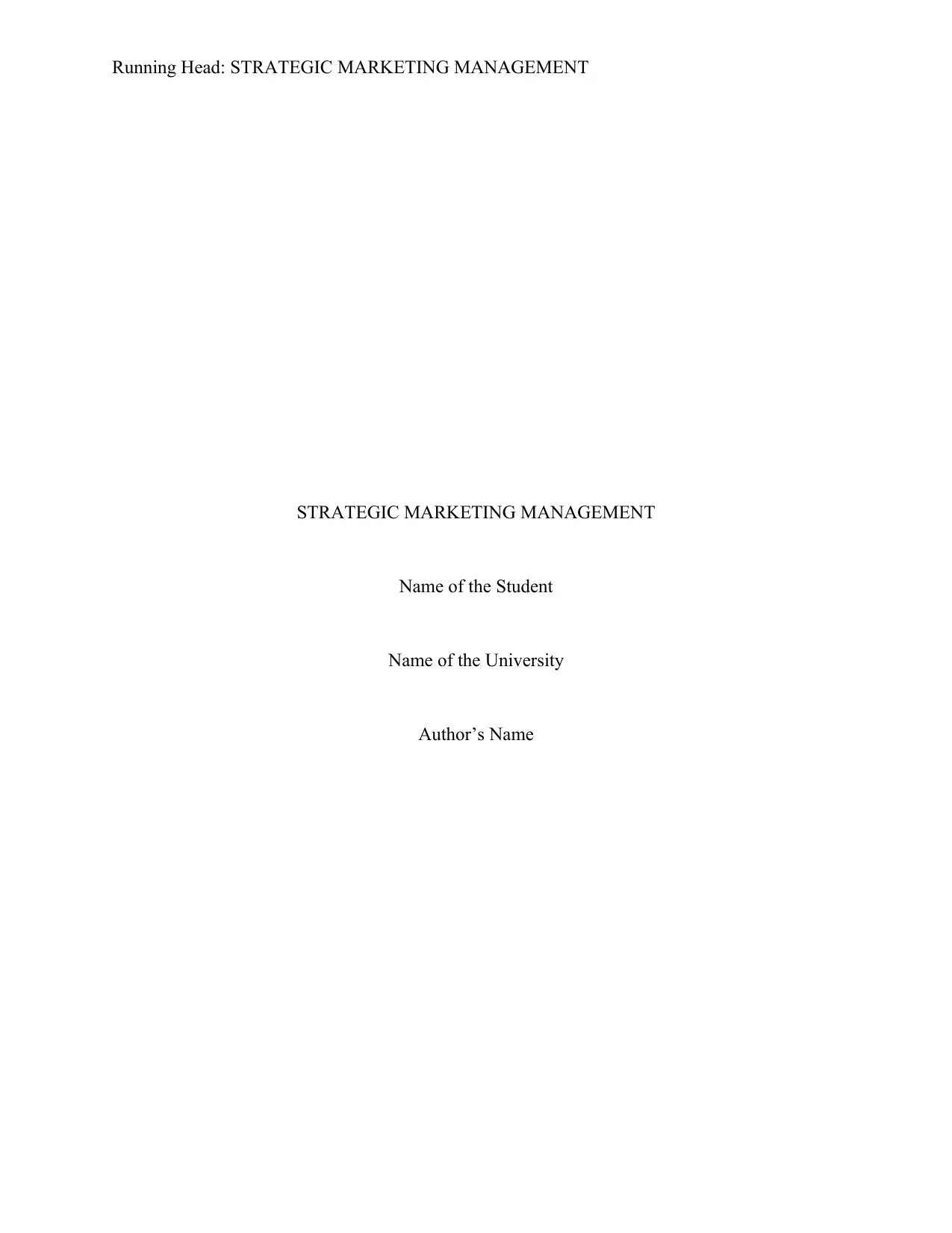
Running Head: STRATEGIC MARKETING MANAGEMENT
STRATEGIC MARKETING MANAGEMENT
Name of the Student
Name of the University
Author’s Name
STRATEGIC MARKETING MANAGEMENT
Name of the Student
Name of the University
Author’s Name
Paraphrase This Document
Need a fresh take? Get an instant paraphrase of this document with our AI Paraphraser
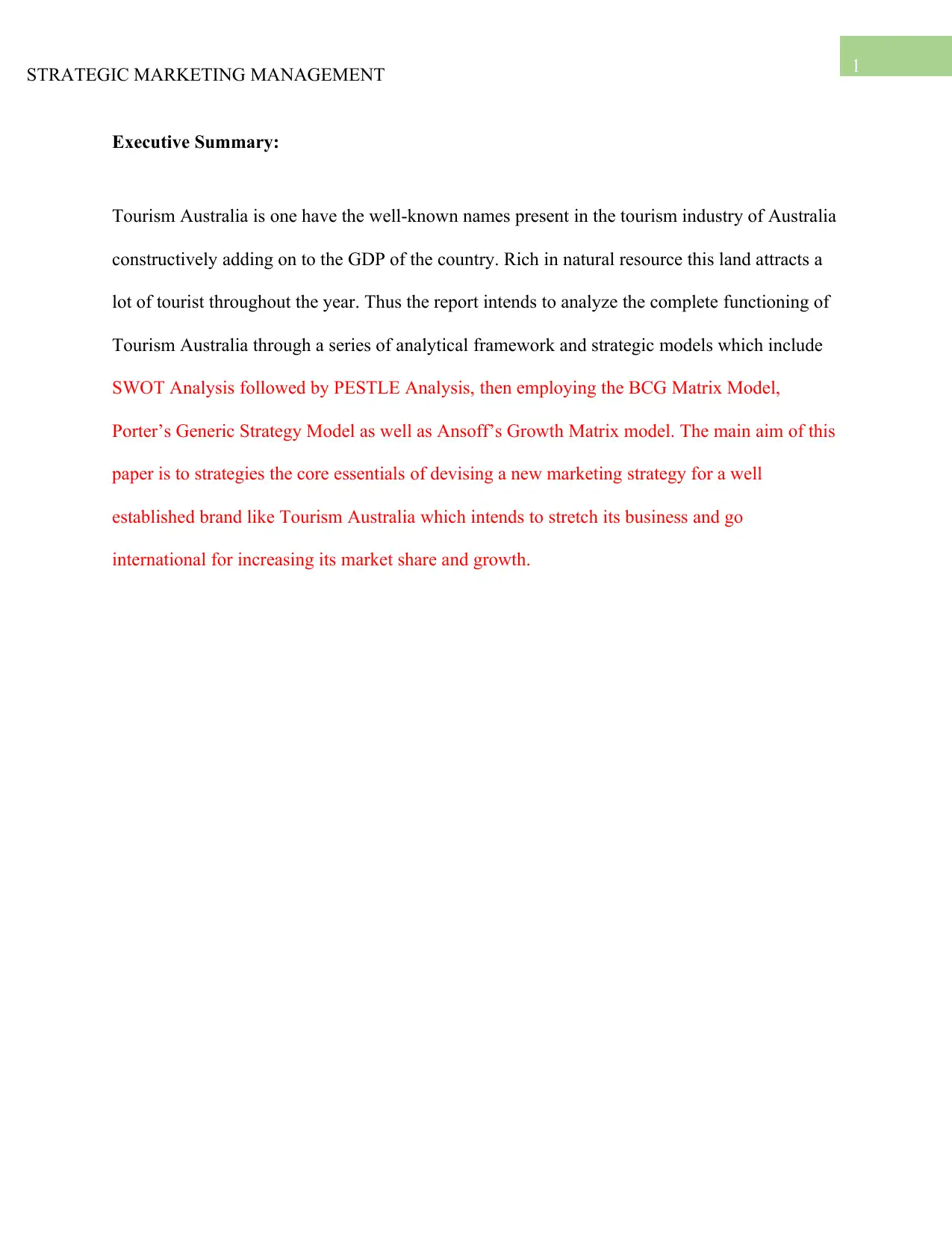
1STRATEGIC MARKETING MANAGEMENT
Executive Summary:
Tourism Australia is one have the well-known names present in the tourism industry of Australia
constructively adding on to the GDP of the country. Rich in natural resource this land attracts a
lot of tourist throughout the year. Thus the report intends to analyze the complete functioning of
Tourism Australia through a series of analytical framework and strategic models which include
SWOT Analysis followed by PESTLE Analysis, then employing the BCG Matrix Model,
Porter’s Generic Strategy Model as well as Ansoff’s Growth Matrix model. The main aim of this
paper is to strategies the core essentials of devising a new marketing strategy for a well
established brand like Tourism Australia which intends to stretch its business and go
international for increasing its market share and growth.
Executive Summary:
Tourism Australia is one have the well-known names present in the tourism industry of Australia
constructively adding on to the GDP of the country. Rich in natural resource this land attracts a
lot of tourist throughout the year. Thus the report intends to analyze the complete functioning of
Tourism Australia through a series of analytical framework and strategic models which include
SWOT Analysis followed by PESTLE Analysis, then employing the BCG Matrix Model,
Porter’s Generic Strategy Model as well as Ansoff’s Growth Matrix model. The main aim of this
paper is to strategies the core essentials of devising a new marketing strategy for a well
established brand like Tourism Australia which intends to stretch its business and go
international for increasing its market share and growth.
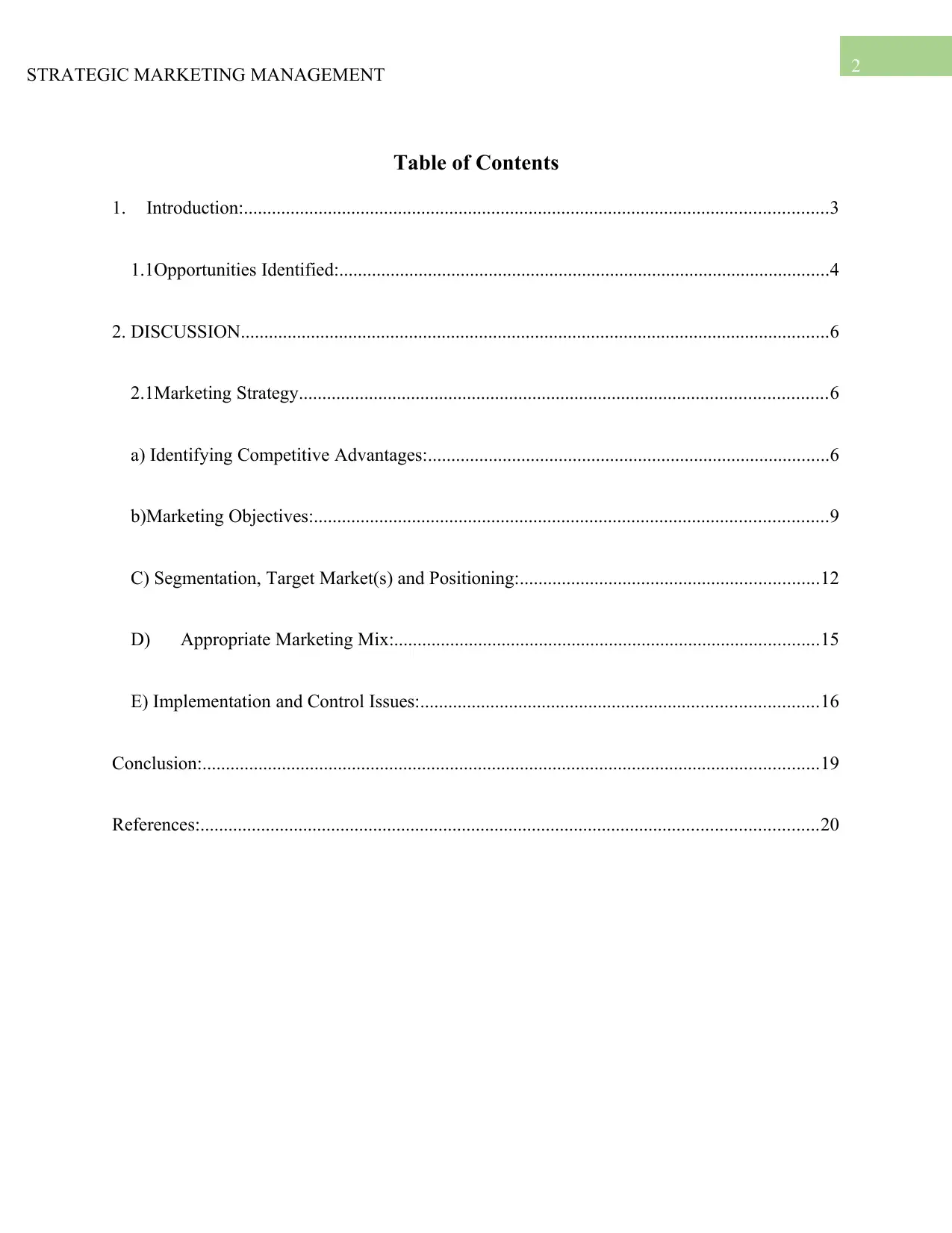
2STRATEGIC MARKETING MANAGEMENT
Table of Contents
1. Introduction:.............................................................................................................................3
1.1Opportunities Identified:.........................................................................................................4
2. DISCUSSION..............................................................................................................................6
2.1Marketing Strategy.................................................................................................................6
a) Identifying Competitive Advantages:......................................................................................6
b)Marketing Objectives:..............................................................................................................9
C) Segmentation, Target Market(s) and Positioning:................................................................12
D) Appropriate Marketing Mix:...........................................................................................15
E) Implementation and Control Issues:.....................................................................................16
Conclusion:....................................................................................................................................19
References:....................................................................................................................................20
Table of Contents
1. Introduction:.............................................................................................................................3
1.1Opportunities Identified:.........................................................................................................4
2. DISCUSSION..............................................................................................................................6
2.1Marketing Strategy.................................................................................................................6
a) Identifying Competitive Advantages:......................................................................................6
b)Marketing Objectives:..............................................................................................................9
C) Segmentation, Target Market(s) and Positioning:................................................................12
D) Appropriate Marketing Mix:...........................................................................................15
E) Implementation and Control Issues:.....................................................................................16
Conclusion:....................................................................................................................................19
References:....................................................................................................................................20
⊘ This is a preview!⊘
Do you want full access?
Subscribe today to unlock all pages.

Trusted by 1+ million students worldwide
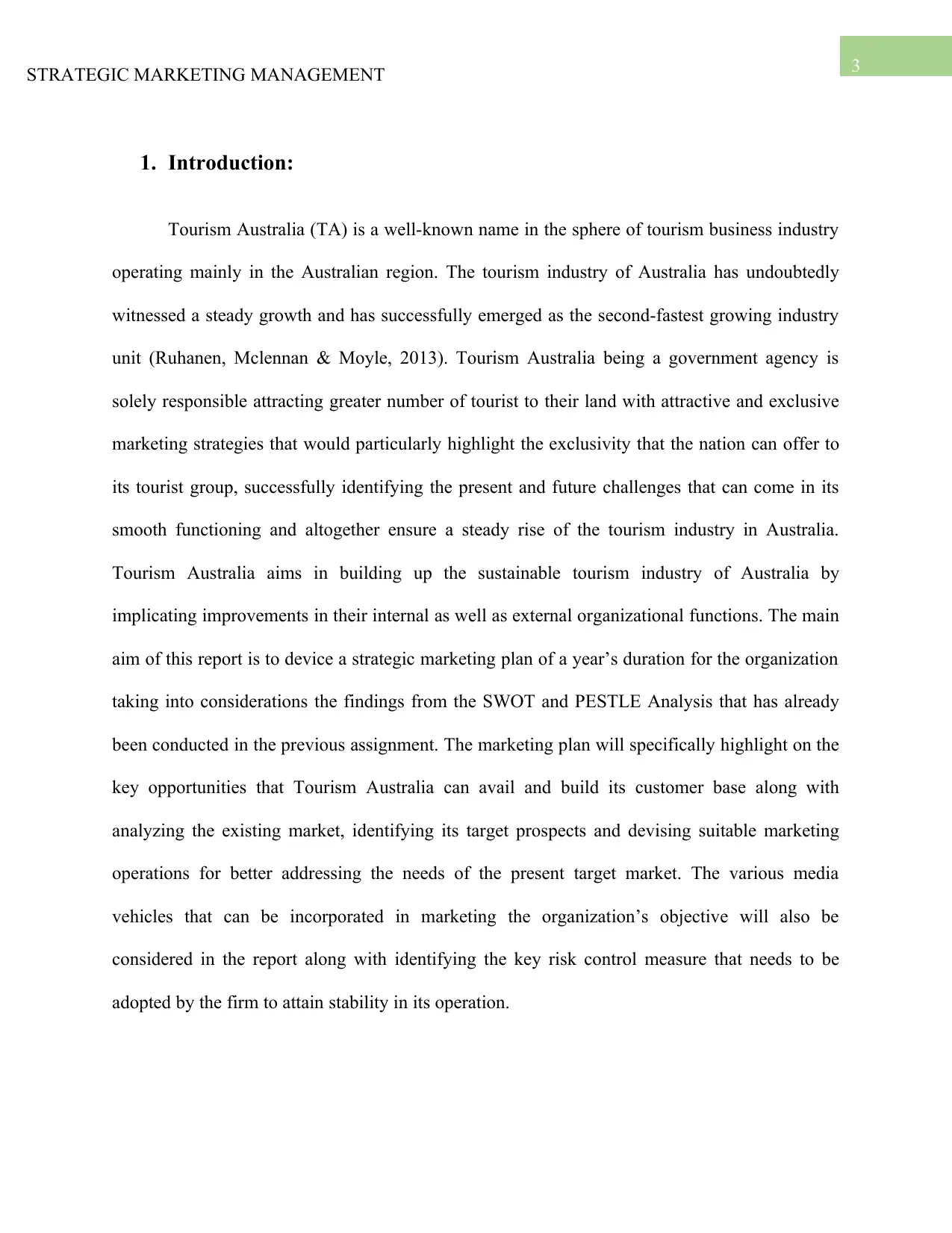
3STRATEGIC MARKETING MANAGEMENT
1. Introduction:
Tourism Australia (TA) is a well-known name in the sphere of tourism business industry
operating mainly in the Australian region. The tourism industry of Australia has undoubtedly
witnessed a steady growth and has successfully emerged as the second-fastest growing industry
unit (Ruhanen, Mclennan & Moyle, 2013). Tourism Australia being a government agency is
solely responsible attracting greater number of tourist to their land with attractive and exclusive
marketing strategies that would particularly highlight the exclusivity that the nation can offer to
its tourist group, successfully identifying the present and future challenges that can come in its
smooth functioning and altogether ensure a steady rise of the tourism industry in Australia.
Tourism Australia aims in building up the sustainable tourism industry of Australia by
implicating improvements in their internal as well as external organizational functions. The main
aim of this report is to device a strategic marketing plan of a year’s duration for the organization
taking into considerations the findings from the SWOT and PESTLE Analysis that has already
been conducted in the previous assignment. The marketing plan will specifically highlight on the
key opportunities that Tourism Australia can avail and build its customer base along with
analyzing the existing market, identifying its target prospects and devising suitable marketing
operations for better addressing the needs of the present target market. The various media
vehicles that can be incorporated in marketing the organization’s objective will also be
considered in the report along with identifying the key risk control measure that needs to be
adopted by the firm to attain stability in its operation.
1. Introduction:
Tourism Australia (TA) is a well-known name in the sphere of tourism business industry
operating mainly in the Australian region. The tourism industry of Australia has undoubtedly
witnessed a steady growth and has successfully emerged as the second-fastest growing industry
unit (Ruhanen, Mclennan & Moyle, 2013). Tourism Australia being a government agency is
solely responsible attracting greater number of tourist to their land with attractive and exclusive
marketing strategies that would particularly highlight the exclusivity that the nation can offer to
its tourist group, successfully identifying the present and future challenges that can come in its
smooth functioning and altogether ensure a steady rise of the tourism industry in Australia.
Tourism Australia aims in building up the sustainable tourism industry of Australia by
implicating improvements in their internal as well as external organizational functions. The main
aim of this report is to device a strategic marketing plan of a year’s duration for the organization
taking into considerations the findings from the SWOT and PESTLE Analysis that has already
been conducted in the previous assignment. The marketing plan will specifically highlight on the
key opportunities that Tourism Australia can avail and build its customer base along with
analyzing the existing market, identifying its target prospects and devising suitable marketing
operations for better addressing the needs of the present target market. The various media
vehicles that can be incorporated in marketing the organization’s objective will also be
considered in the report along with identifying the key risk control measure that needs to be
adopted by the firm to attain stability in its operation.
Paraphrase This Document
Need a fresh take? Get an instant paraphrase of this document with our AI Paraphraser
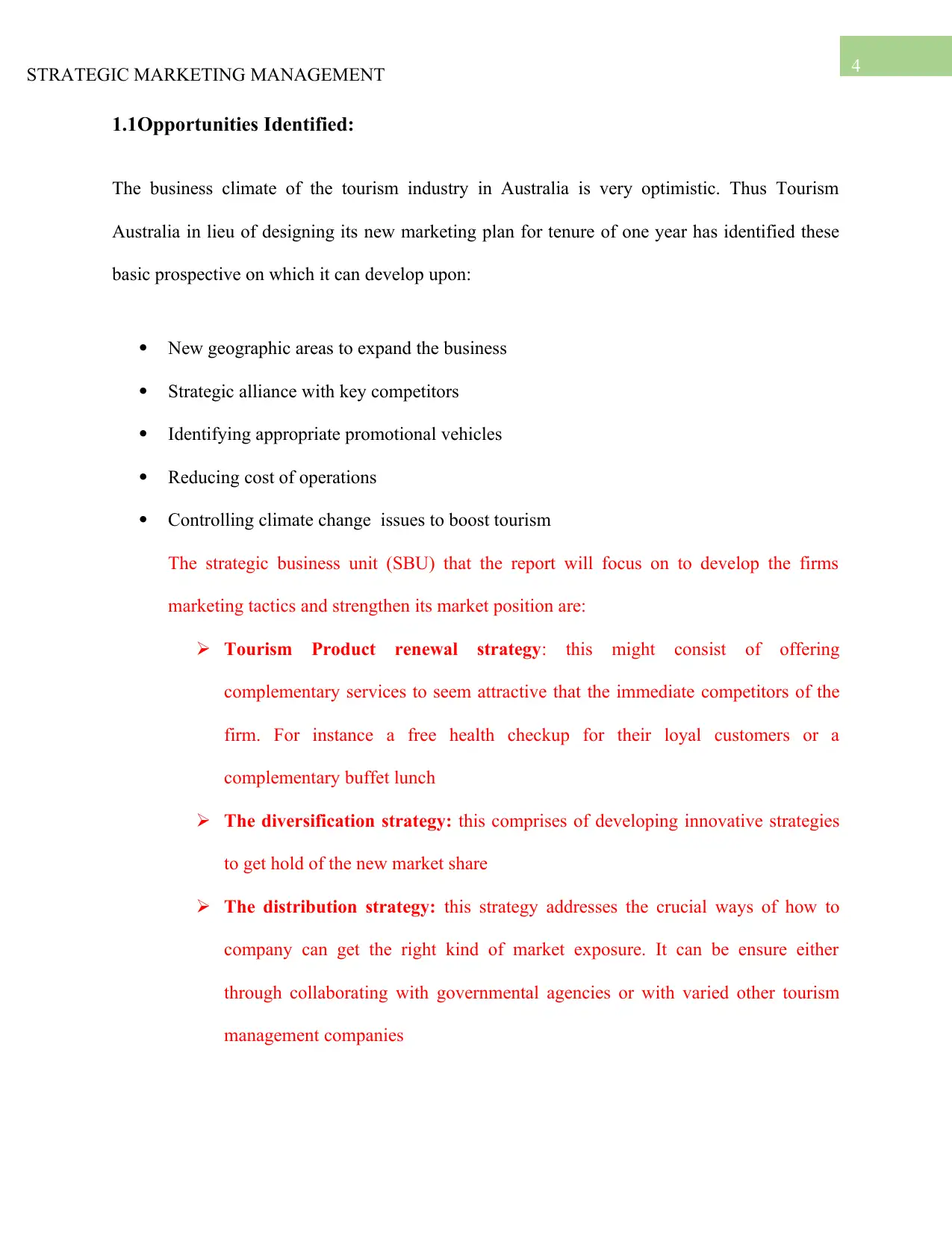
4STRATEGIC MARKETING MANAGEMENT
1.1Opportunities Identified:
The business climate of the tourism industry in Australia is very optimistic. Thus Tourism
Australia in lieu of designing its new marketing plan for tenure of one year has identified these
basic prospective on which it can develop upon:
New geographic areas to expand the business
Strategic alliance with key competitors
Identifying appropriate promotional vehicles
Reducing cost of operations
Controlling climate change issues to boost tourism
The strategic business unit (SBU) that the report will focus on to develop the firms
marketing tactics and strengthen its market position are:
Tourism Product renewal strategy: this might consist of offering
complementary services to seem attractive that the immediate competitors of the
firm. For instance a free health checkup for their loyal customers or a
complementary buffet lunch
The diversification strategy: this comprises of developing innovative strategies
to get hold of the new market share
The distribution strategy: this strategy addresses the crucial ways of how to
company can get the right kind of market exposure. It can be ensure either
through collaborating with governmental agencies or with varied other tourism
management companies
1.1Opportunities Identified:
The business climate of the tourism industry in Australia is very optimistic. Thus Tourism
Australia in lieu of designing its new marketing plan for tenure of one year has identified these
basic prospective on which it can develop upon:
New geographic areas to expand the business
Strategic alliance with key competitors
Identifying appropriate promotional vehicles
Reducing cost of operations
Controlling climate change issues to boost tourism
The strategic business unit (SBU) that the report will focus on to develop the firms
marketing tactics and strengthen its market position are:
Tourism Product renewal strategy: this might consist of offering
complementary services to seem attractive that the immediate competitors of the
firm. For instance a free health checkup for their loyal customers or a
complementary buffet lunch
The diversification strategy: this comprises of developing innovative strategies
to get hold of the new market share
The distribution strategy: this strategy addresses the crucial ways of how to
company can get the right kind of market exposure. It can be ensure either
through collaborating with governmental agencies or with varied other tourism
management companies
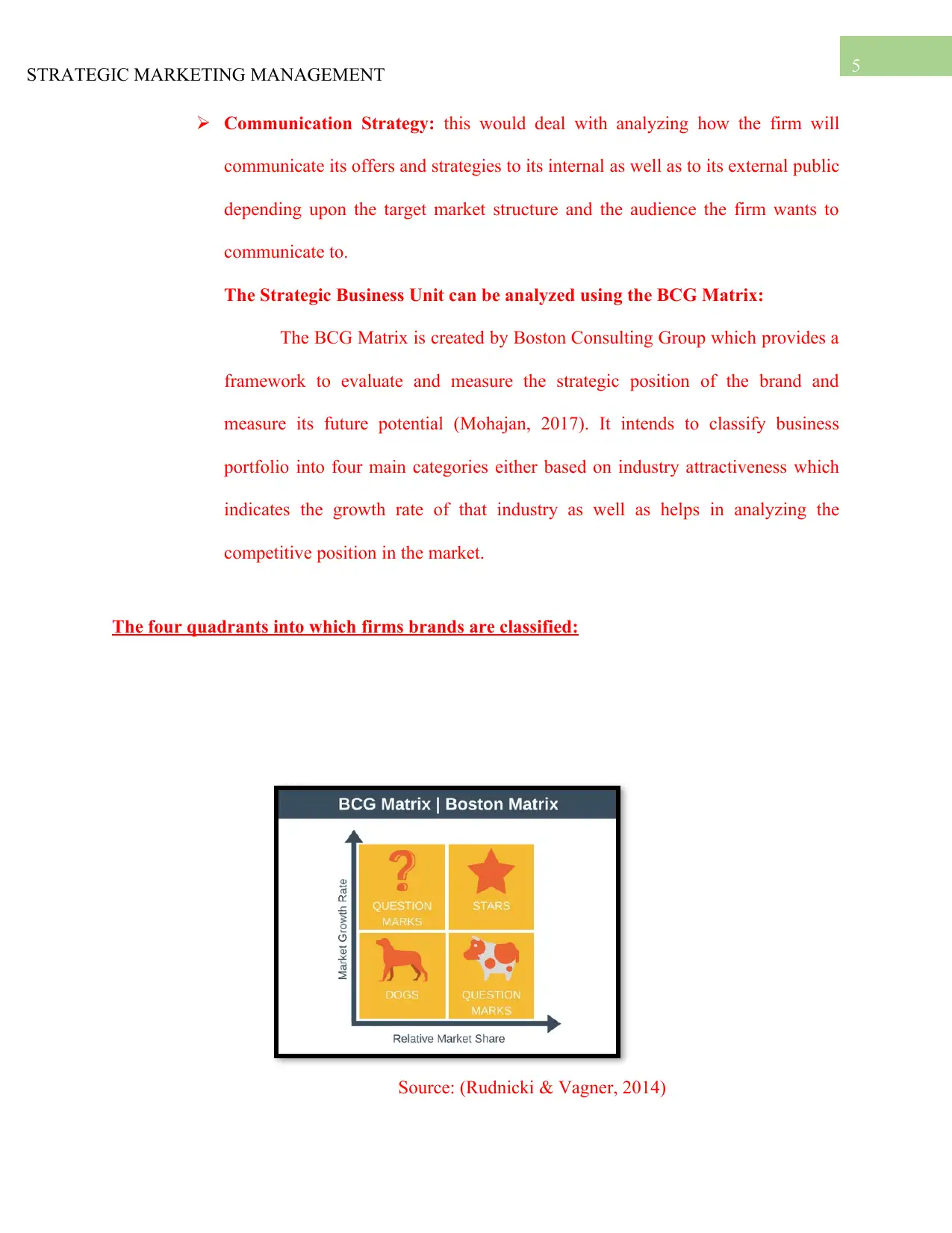
5STRATEGIC MARKETING MANAGEMENT
Communication Strategy: this would deal with analyzing how the firm will
communicate its offers and strategies to its internal as well as to its external public
depending upon the target market structure and the audience the firm wants to
communicate to.
The Strategic Business Unit can be analyzed using the BCG Matrix:
The BCG Matrix is created by Boston Consulting Group which provides a
framework to evaluate and measure the strategic position of the brand and
measure its future potential (Mohajan, 2017). It intends to classify business
portfolio into four main categories either based on industry attractiveness which
indicates the growth rate of that industry as well as helps in analyzing the
competitive position in the market.
The four quadrants into which firms brands are classified:
Source: (Rudnicki & Vagner, 2014)
Communication Strategy: this would deal with analyzing how the firm will
communicate its offers and strategies to its internal as well as to its external public
depending upon the target market structure and the audience the firm wants to
communicate to.
The Strategic Business Unit can be analyzed using the BCG Matrix:
The BCG Matrix is created by Boston Consulting Group which provides a
framework to evaluate and measure the strategic position of the brand and
measure its future potential (Mohajan, 2017). It intends to classify business
portfolio into four main categories either based on industry attractiveness which
indicates the growth rate of that industry as well as helps in analyzing the
competitive position in the market.
The four quadrants into which firms brands are classified:
Source: (Rudnicki & Vagner, 2014)
⊘ This is a preview!⊘
Do you want full access?
Subscribe today to unlock all pages.

Trusted by 1+ million students worldwide
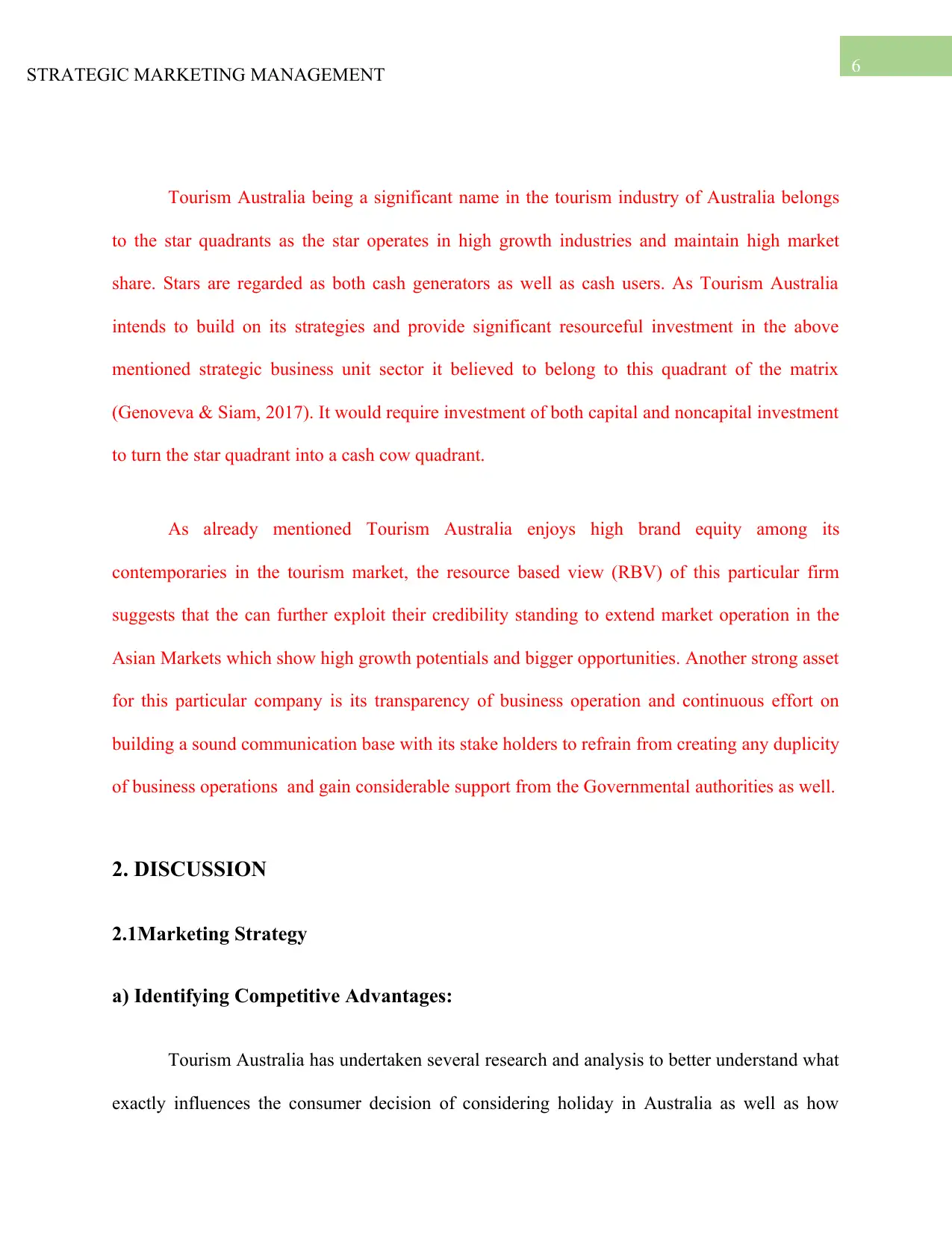
6STRATEGIC MARKETING MANAGEMENT
Tourism Australia being a significant name in the tourism industry of Australia belongs
to the star quadrants as the star operates in high growth industries and maintain high market
share. Stars are regarded as both cash generators as well as cash users. As Tourism Australia
intends to build on its strategies and provide significant resourceful investment in the above
mentioned strategic business unit sector it believed to belong to this quadrant of the matrix
(Genoveva & Siam, 2017). It would require investment of both capital and noncapital investment
to turn the star quadrant into a cash cow quadrant.
As already mentioned Tourism Australia enjoys high brand equity among its
contemporaries in the tourism market, the resource based view (RBV) of this particular firm
suggests that the can further exploit their credibility standing to extend market operation in the
Asian Markets which show high growth potentials and bigger opportunities. Another strong asset
for this particular company is its transparency of business operation and continuous effort on
building a sound communication base with its stake holders to refrain from creating any duplicity
of business operations and gain considerable support from the Governmental authorities as well.
2. DISCUSSION
2.1Marketing Strategy
a) Identifying Competitive Advantages:
Tourism Australia has undertaken several research and analysis to better understand what
exactly influences the consumer decision of considering holiday in Australia as well as how
Tourism Australia being a significant name in the tourism industry of Australia belongs
to the star quadrants as the star operates in high growth industries and maintain high market
share. Stars are regarded as both cash generators as well as cash users. As Tourism Australia
intends to build on its strategies and provide significant resourceful investment in the above
mentioned strategic business unit sector it believed to belong to this quadrant of the matrix
(Genoveva & Siam, 2017). It would require investment of both capital and noncapital investment
to turn the star quadrant into a cash cow quadrant.
As already mentioned Tourism Australia enjoys high brand equity among its
contemporaries in the tourism market, the resource based view (RBV) of this particular firm
suggests that the can further exploit their credibility standing to extend market operation in the
Asian Markets which show high growth potentials and bigger opportunities. Another strong asset
for this particular company is its transparency of business operation and continuous effort on
building a sound communication base with its stake holders to refrain from creating any duplicity
of business operations and gain considerable support from the Governmental authorities as well.
2. DISCUSSION
2.1Marketing Strategy
a) Identifying Competitive Advantages:
Tourism Australia has undertaken several research and analysis to better understand what
exactly influences the consumer decision of considering holiday in Australia as well as how
Paraphrase This Document
Need a fresh take? Get an instant paraphrase of this document with our AI Paraphraser
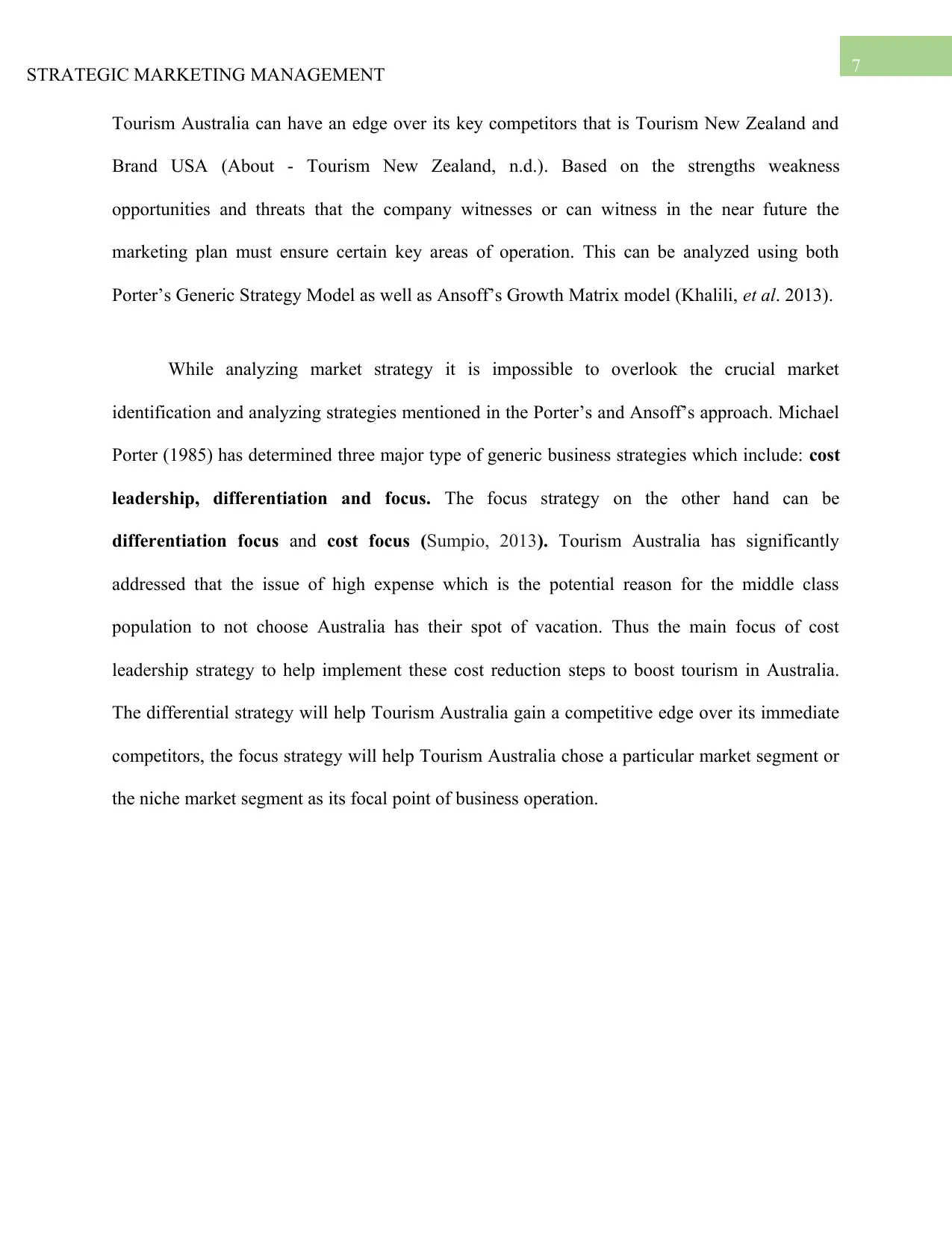
7STRATEGIC MARKETING MANAGEMENT
Tourism Australia can have an edge over its key competitors that is Tourism New Zealand and
Brand USA (About - Tourism New Zealand, n.d.). Based on the strengths weakness
opportunities and threats that the company witnesses or can witness in the near future the
marketing plan must ensure certain key areas of operation. This can be analyzed using both
Porter’s Generic Strategy Model as well as Ansoff’s Growth Matrix model (Khalili, et al. 2013).
While analyzing market strategy it is impossible to overlook the crucial market
identification and analyzing strategies mentioned in the Porter’s and Ansoff’s approach. Michael
Porter (1985) has determined three major type of generic business strategies which include: cost
leadership, differentiation and focus. The focus strategy on the other hand can be
differentiation focus and cost focus (Sumpio, 2013). Tourism Australia has significantly
addressed that the issue of high expense which is the potential reason for the middle class
population to not choose Australia has their spot of vacation. Thus the main focus of cost
leadership strategy to help implement these cost reduction steps to boost tourism in Australia.
The differential strategy will help Tourism Australia gain a competitive edge over its immediate
competitors, the focus strategy will help Tourism Australia chose a particular market segment or
the niche market segment as its focal point of business operation.
Tourism Australia can have an edge over its key competitors that is Tourism New Zealand and
Brand USA (About - Tourism New Zealand, n.d.). Based on the strengths weakness
opportunities and threats that the company witnesses or can witness in the near future the
marketing plan must ensure certain key areas of operation. This can be analyzed using both
Porter’s Generic Strategy Model as well as Ansoff’s Growth Matrix model (Khalili, et al. 2013).
While analyzing market strategy it is impossible to overlook the crucial market
identification and analyzing strategies mentioned in the Porter’s and Ansoff’s approach. Michael
Porter (1985) has determined three major type of generic business strategies which include: cost
leadership, differentiation and focus. The focus strategy on the other hand can be
differentiation focus and cost focus (Sumpio, 2013). Tourism Australia has significantly
addressed that the issue of high expense which is the potential reason for the middle class
population to not choose Australia has their spot of vacation. Thus the main focus of cost
leadership strategy to help implement these cost reduction steps to boost tourism in Australia.
The differential strategy will help Tourism Australia gain a competitive edge over its immediate
competitors, the focus strategy will help Tourism Australia chose a particular market segment or
the niche market segment as its focal point of business operation.
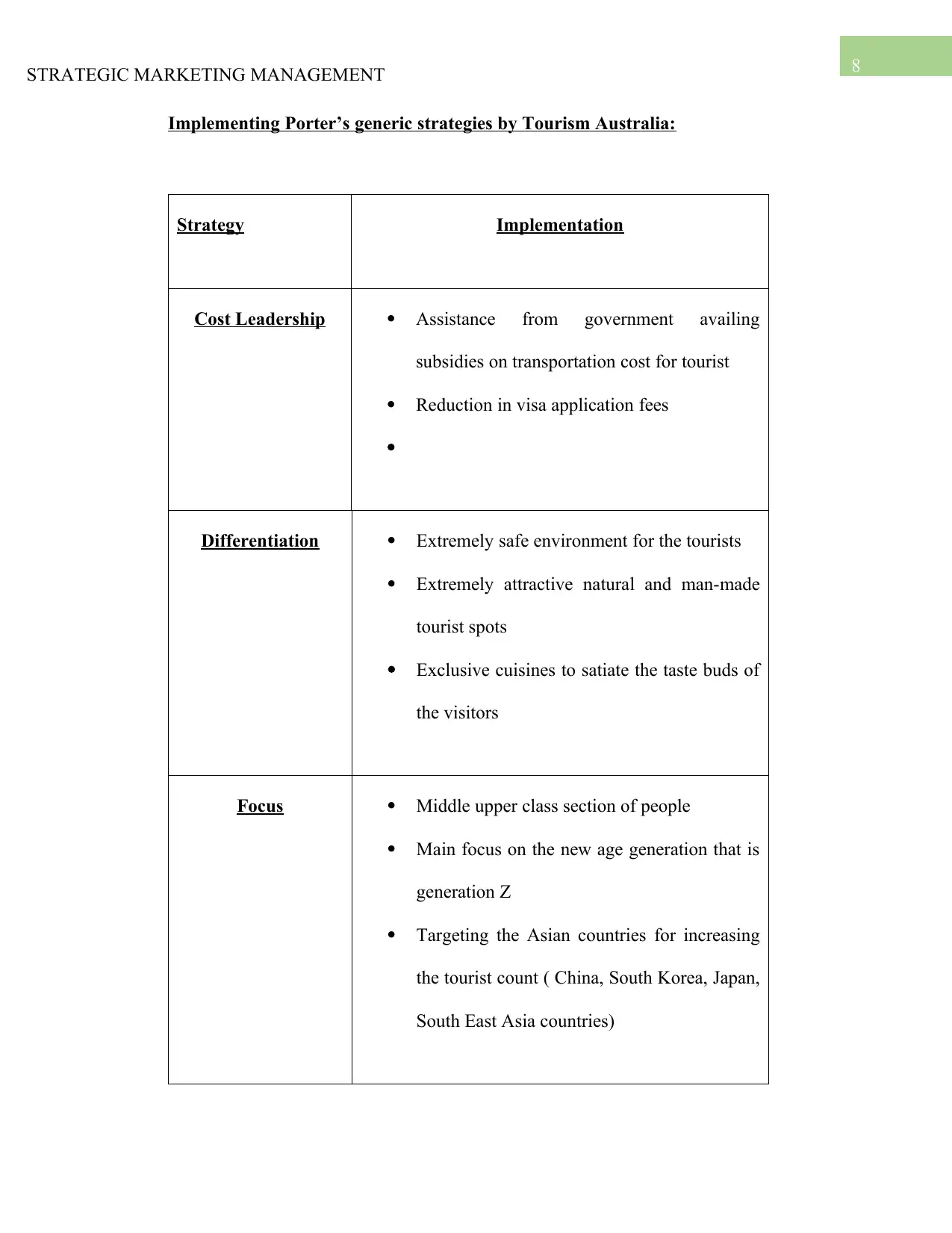
8STRATEGIC MARKETING MANAGEMENT
Implementing Porter’s generic strategies by Tourism Australia:
Strategy Implementation
Cost Leadership Assistance from government availing
subsidies on transportation cost for tourist
Reduction in visa application fees
Differentiation Extremely safe environment for the tourists
Extremely attractive natural and man-made
tourist spots
Exclusive cuisines to satiate the taste buds of
the visitors
Focus Middle upper class section of people
Main focus on the new age generation that is
generation Z
Targeting the Asian countries for increasing
the tourist count ( China, South Korea, Japan,
South East Asia countries)
Implementing Porter’s generic strategies by Tourism Australia:
Strategy Implementation
Cost Leadership Assistance from government availing
subsidies on transportation cost for tourist
Reduction in visa application fees
Differentiation Extremely safe environment for the tourists
Extremely attractive natural and man-made
tourist spots
Exclusive cuisines to satiate the taste buds of
the visitors
Focus Middle upper class section of people
Main focus on the new age generation that is
generation Z
Targeting the Asian countries for increasing
the tourist count ( China, South Korea, Japan,
South East Asia countries)
⊘ This is a preview!⊘
Do you want full access?
Subscribe today to unlock all pages.

Trusted by 1+ million students worldwide
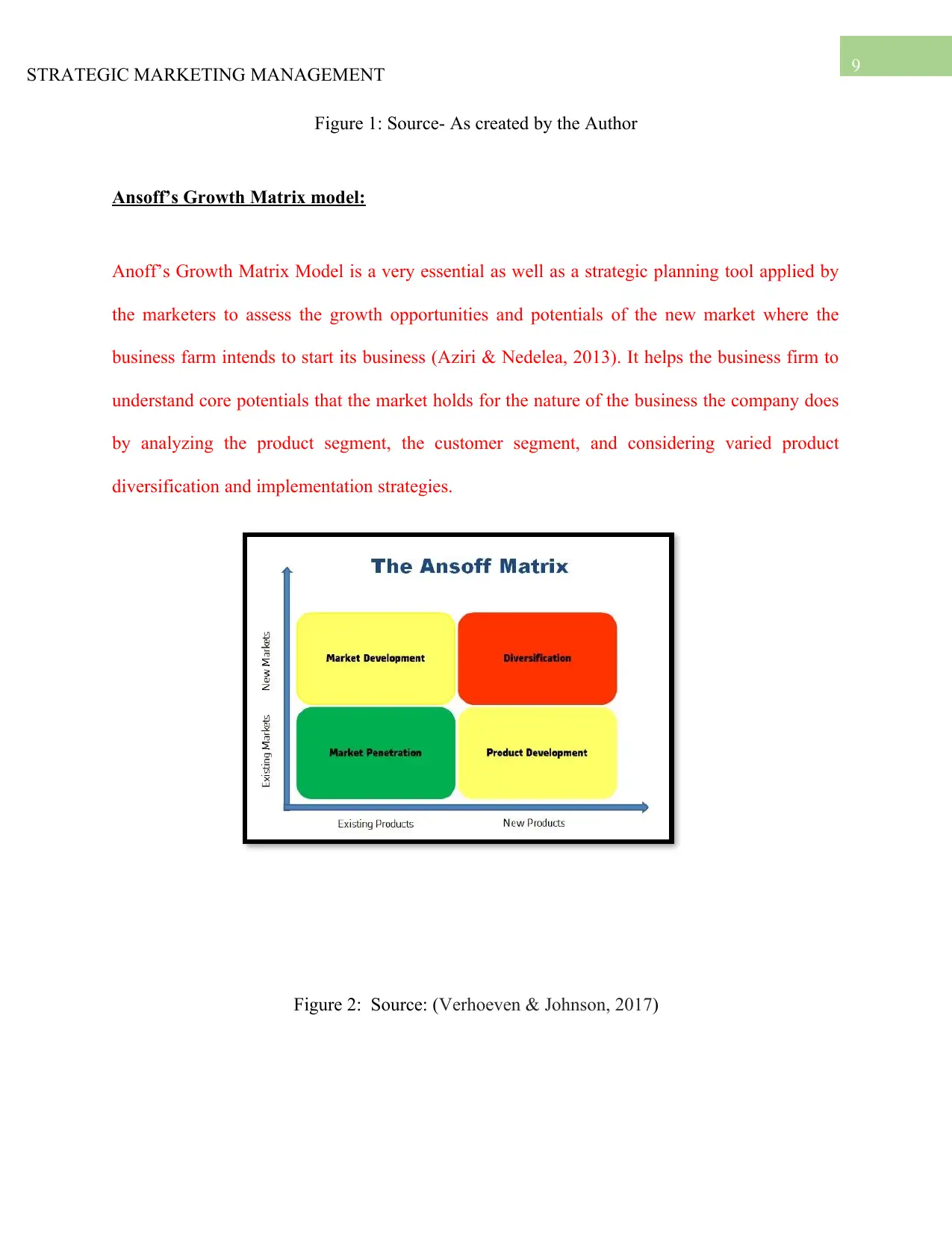
9STRATEGIC MARKETING MANAGEMENT
Figure 1: Source- As created by the Author
Ansoff’s Growth Matrix model:
Anoff’s Growth Matrix Model is a very essential as well as a strategic planning tool applied by
the marketers to assess the growth opportunities and potentials of the new market where the
business farm intends to start its business (Aziri & Nedelea, 2013). It helps the business firm to
understand core potentials that the market holds for the nature of the business the company does
by analyzing the product segment, the customer segment, and considering varied product
diversification and implementation strategies.
Figure 2: Source: (Verhoeven & Johnson, 2017)
Figure 1: Source- As created by the Author
Ansoff’s Growth Matrix model:
Anoff’s Growth Matrix Model is a very essential as well as a strategic planning tool applied by
the marketers to assess the growth opportunities and potentials of the new market where the
business farm intends to start its business (Aziri & Nedelea, 2013). It helps the business firm to
understand core potentials that the market holds for the nature of the business the company does
by analyzing the product segment, the customer segment, and considering varied product
diversification and implementation strategies.
Figure 2: Source: (Verhoeven & Johnson, 2017)
Paraphrase This Document
Need a fresh take? Get an instant paraphrase of this document with our AI Paraphraser
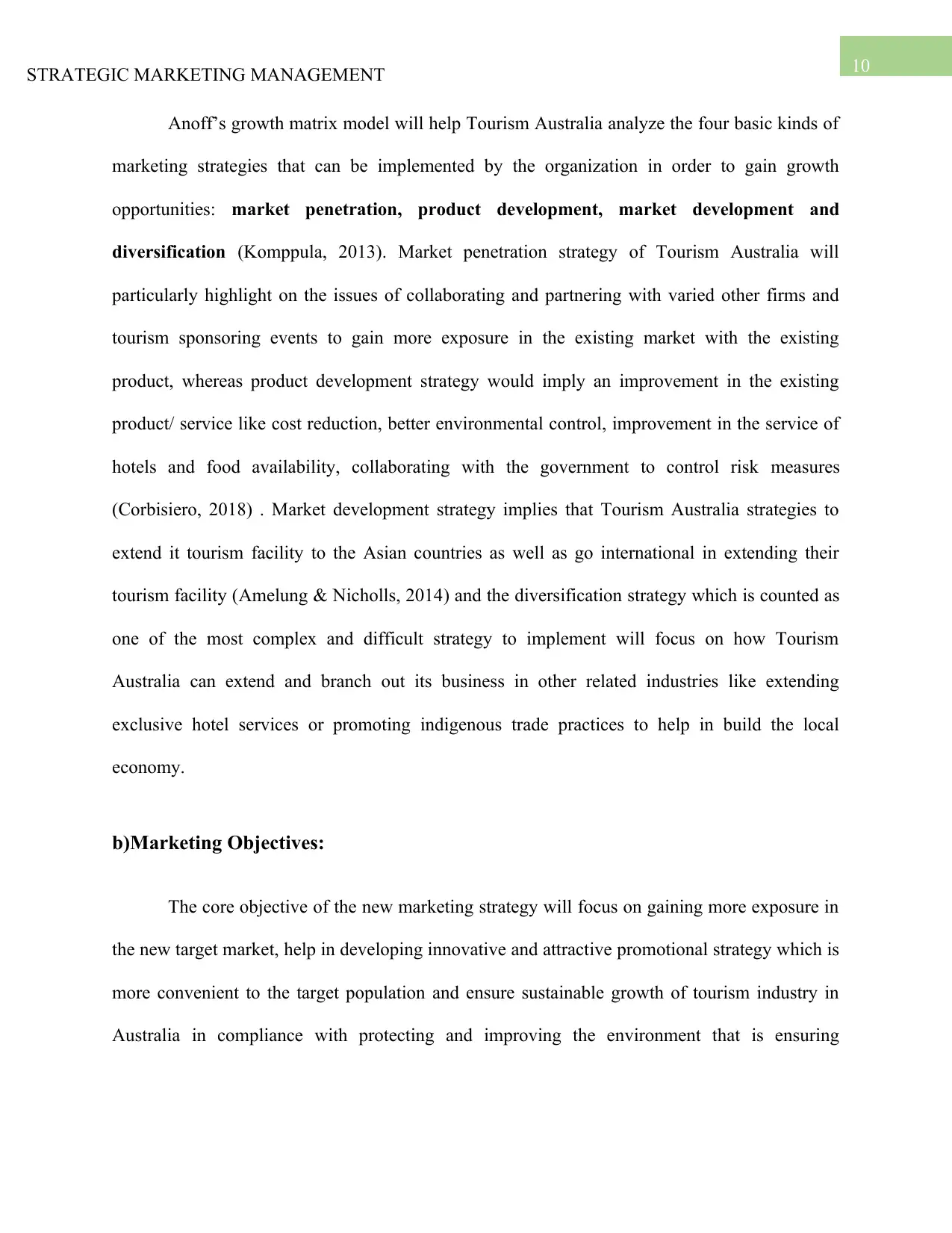
10STRATEGIC MARKETING MANAGEMENT
Anoff’s growth matrix model will help Tourism Australia analyze the four basic kinds of
marketing strategies that can be implemented by the organization in order to gain growth
opportunities: market penetration, product development, market development and
diversification (Komppula, 2013). Market penetration strategy of Tourism Australia will
particularly highlight on the issues of collaborating and partnering with varied other firms and
tourism sponsoring events to gain more exposure in the existing market with the existing
product, whereas product development strategy would imply an improvement in the existing
product/ service like cost reduction, better environmental control, improvement in the service of
hotels and food availability, collaborating with the government to control risk measures
(Corbisiero, 2018) . Market development strategy implies that Tourism Australia strategies to
extend it tourism facility to the Asian countries as well as go international in extending their
tourism facility (Amelung & Nicholls, 2014) and the diversification strategy which is counted as
one of the most complex and difficult strategy to implement will focus on how Tourism
Australia can extend and branch out its business in other related industries like extending
exclusive hotel services or promoting indigenous trade practices to help in build the local
economy.
b)Marketing Objectives:
The core objective of the new marketing strategy will focus on gaining more exposure in
the new target market, help in developing innovative and attractive promotional strategy which is
more convenient to the target population and ensure sustainable growth of tourism industry in
Australia in compliance with protecting and improving the environment that is ensuring
Anoff’s growth matrix model will help Tourism Australia analyze the four basic kinds of
marketing strategies that can be implemented by the organization in order to gain growth
opportunities: market penetration, product development, market development and
diversification (Komppula, 2013). Market penetration strategy of Tourism Australia will
particularly highlight on the issues of collaborating and partnering with varied other firms and
tourism sponsoring events to gain more exposure in the existing market with the existing
product, whereas product development strategy would imply an improvement in the existing
product/ service like cost reduction, better environmental control, improvement in the service of
hotels and food availability, collaborating with the government to control risk measures
(Corbisiero, 2018) . Market development strategy implies that Tourism Australia strategies to
extend it tourism facility to the Asian countries as well as go international in extending their
tourism facility (Amelung & Nicholls, 2014) and the diversification strategy which is counted as
one of the most complex and difficult strategy to implement will focus on how Tourism
Australia can extend and branch out its business in other related industries like extending
exclusive hotel services or promoting indigenous trade practices to help in build the local
economy.
b)Marketing Objectives:
The core objective of the new marketing strategy will focus on gaining more exposure in
the new target market, help in developing innovative and attractive promotional strategy which is
more convenient to the target population and ensure sustainable growth of tourism industry in
Australia in compliance with protecting and improving the environment that is ensuring
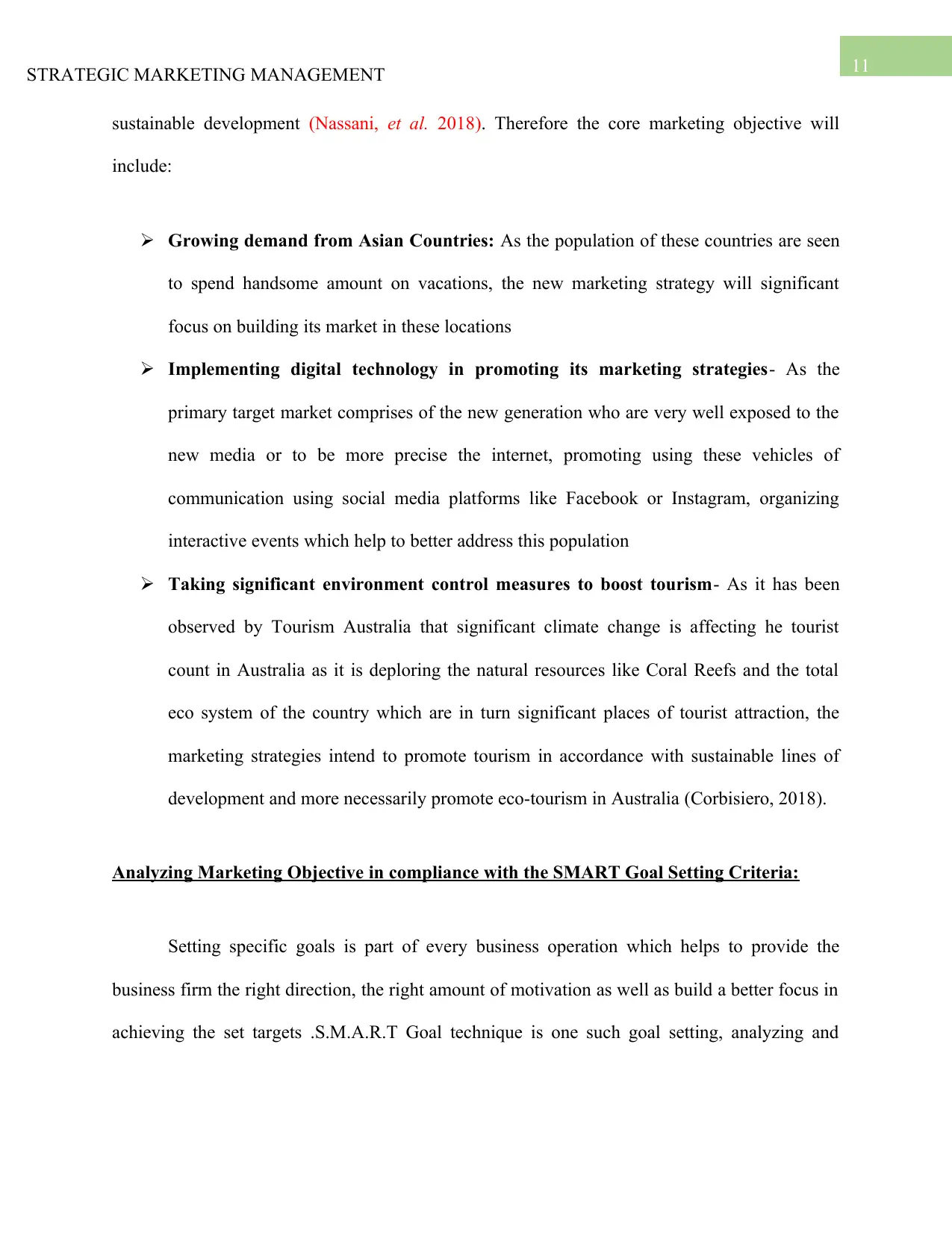
11STRATEGIC MARKETING MANAGEMENT
sustainable development (Nassani, et al. 2018). Therefore the core marketing objective will
include:
Growing demand from Asian Countries: As the population of these countries are seen
to spend handsome amount on vacations, the new marketing strategy will significant
focus on building its market in these locations
Implementing digital technology in promoting its marketing strategies- As the
primary target market comprises of the new generation who are very well exposed to the
new media or to be more precise the internet, promoting using these vehicles of
communication using social media platforms like Facebook or Instagram, organizing
interactive events which help to better address this population
Taking significant environment control measures to boost tourism- As it has been
observed by Tourism Australia that significant climate change is affecting he tourist
count in Australia as it is deploring the natural resources like Coral Reefs and the total
eco system of the country which are in turn significant places of tourist attraction, the
marketing strategies intend to promote tourism in accordance with sustainable lines of
development and more necessarily promote eco-tourism in Australia (Corbisiero, 2018).
Analyzing Marketing Objective in compliance with the SMART Goal Setting Criteria:
Setting specific goals is part of every business operation which helps to provide the
business firm the right direction, the right amount of motivation as well as build a better focus in
achieving the set targets .S.M.A.R.T Goal technique is one such goal setting, analyzing and
sustainable development (Nassani, et al. 2018). Therefore the core marketing objective will
include:
Growing demand from Asian Countries: As the population of these countries are seen
to spend handsome amount on vacations, the new marketing strategy will significant
focus on building its market in these locations
Implementing digital technology in promoting its marketing strategies- As the
primary target market comprises of the new generation who are very well exposed to the
new media or to be more precise the internet, promoting using these vehicles of
communication using social media platforms like Facebook or Instagram, organizing
interactive events which help to better address this population
Taking significant environment control measures to boost tourism- As it has been
observed by Tourism Australia that significant climate change is affecting he tourist
count in Australia as it is deploring the natural resources like Coral Reefs and the total
eco system of the country which are in turn significant places of tourist attraction, the
marketing strategies intend to promote tourism in accordance with sustainable lines of
development and more necessarily promote eco-tourism in Australia (Corbisiero, 2018).
Analyzing Marketing Objective in compliance with the SMART Goal Setting Criteria:
Setting specific goals is part of every business operation which helps to provide the
business firm the right direction, the right amount of motivation as well as build a better focus in
achieving the set targets .S.M.A.R.T Goal technique is one such goal setting, analyzing and
⊘ This is a preview!⊘
Do you want full access?
Subscribe today to unlock all pages.

Trusted by 1+ million students worldwide
1 out of 24
Related Documents
Your All-in-One AI-Powered Toolkit for Academic Success.
+13062052269
info@desklib.com
Available 24*7 on WhatsApp / Email
![[object Object]](/_next/static/media/star-bottom.7253800d.svg)
Unlock your academic potential
Copyright © 2020–2025 A2Z Services. All Rights Reserved. Developed and managed by ZUCOL.



